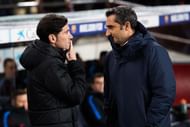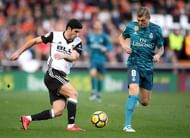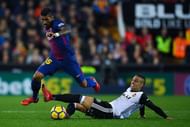Valencia is one of Spain's most successful club, with six La Liga titles to its name. They include two in three years, in 2001-2002 and 2003-2004, under manager Rafa Benitez and featuring players like Rubén Baraja, David Albelda, Vicente Rodriguez, John Carew, Pablo Aimar and Mista.
Being a club with such reputation, fans expect more from them but during the past few years, they have struggled to achieve any significant glory in Spain. Last season they finished 12th in La Liga but with the arrival of Marcelino, they are fighting for a top-three spot in the La Liga table. This has been a big turnaround for the club. Let's take a look at the tactics used by Marcelino which resurrected Valencia from the dust.
#5 The 4-4-2 formation

Before the start of the season, no one expected Valencia to even get a Champions League spot but with Marcelino's redefined 4-4-2 formation, they are right up there sitting at the third position in La Liga.
Marcelino arrives with quite a reputation for himself, having previously taken Villarreal to lofty heights in La Liga and in Europe on a fairly limited budget compared to the division's big hitters, where his 4-4-2 also enjoyed plenty of success.
The Spaniard believes in players having set roles with a fairly rigid 4-4-2 system, which relies upon defending as a unit and then trying to break away the pace to cause the opposition problems in transition.
#4 The key player: Dani Parejo

Dani Parejo is the main playmaker of this Valencia team. Partnered with Geoffrey Kondogbia in the centre of midfield, the two are both very comfortable on the ball, but the Spaniard holds the reins when it comes to dictating the tempo and the incisiveness of Valencia's play.
Often, Kondogbia screens the defence and has the further responsibility in terms of chasing back and aiding his central defensive duo when possession turns over. A sliding leg from the Frenchman is something that opponents have grown used to being thwarted by this season.
#3 The midfield combination

Carlos Soler, Goncalo Guedes, Nacho Gil (he has now been loaned), and Andreas Pereira have shared the responsibility of playing the interior roles in midfield. Fitting into the midfield four in the wide areas, they have the license to come inside and combine with their strike force, as well as the awareness required to link up with the likes of Martín Montoya and José Gayà, galloping up to support as full-backs.
Fed often by passes from their captain Parejo, the interiors provide the drive and pace on the counter-attack, with all four capable of dribbling in at speed help Valencia transition upfield hastily.
#2 Rodrigo playing dual role

Rodrigo Moreno has been a key facet of Valencia's attack, battling back against all odds to get himself into favour once again. The former Benfica youngster has earned himself Spain call-ups off the back of his good work as a second striker.
While Rodrigo plays as a midfielder he has been a key part of the defence also. Keen to drop in and offer himself as a wall to his midfield options, Rodrigo is very much the reference point for any quick vertical passes through the lines at Valencia. He can play flicks into his strike partner or try to feed passes into wider areas to enable link-up play between the interiors and the overlapping fullbacks.
Rodrigo works incredibly hard to press and harry opponents, but the link-up play involved in his role is what has made him so indispensable. His selfless work for the cause allows a more direct No. 9 like Simone Zaza to lead the line with a little bit more freedom. This allows the Italian to take up a more advanced position where he would be better suited to meet early crosses from the flanks.
#1 Defensive play of Valencia

Marcelino's 4-4-2 relies on very compact defending to try and frustrate opponents. When possession turns over, the midfield four must put in the hard running to get back into their shape with the focus of their press being quite ball-orientated.
By ensuring that a player heading down the right flank is met by their wide man being marked and a spare man coming across to close them down as well as Valencia's second striker enveloping him from the rear, it makes more risky and ambitious diagonal balls seem like the best way to break Valencia down.
By baiting these risky passes from opponents, it creates opportunities for the team to win the ball back and then be capable of breaking at pace into a stretched opposition. Should opponents overextend and try such passes to spare men on the far side, it ensures that if the intended recipient of the diagonal isn't found, he is automatically out of the game when Valencia counter at speed.
With one of Parejo or Kondogbia happy to shuffle across and help their full-backs and interior press, it makes Valencia incredibly hard to play through with attempting to switch the play at pace. Marcelino's style is very positive. It's quick and vertical when his side wins the ball back as well as when an opponent is caught out of shape. Using players that are very quick such as Guedes, Valencia can turn an opponent's mistake into a chance of their own within 15 seconds.
It has made Valencia into one of the more fearsome propositions in La Liga this season with their blend of steely defensive organization, sheer speed, and a clinical edge on the break. A lethal cocktail, both at Mestalla and on their travels.
